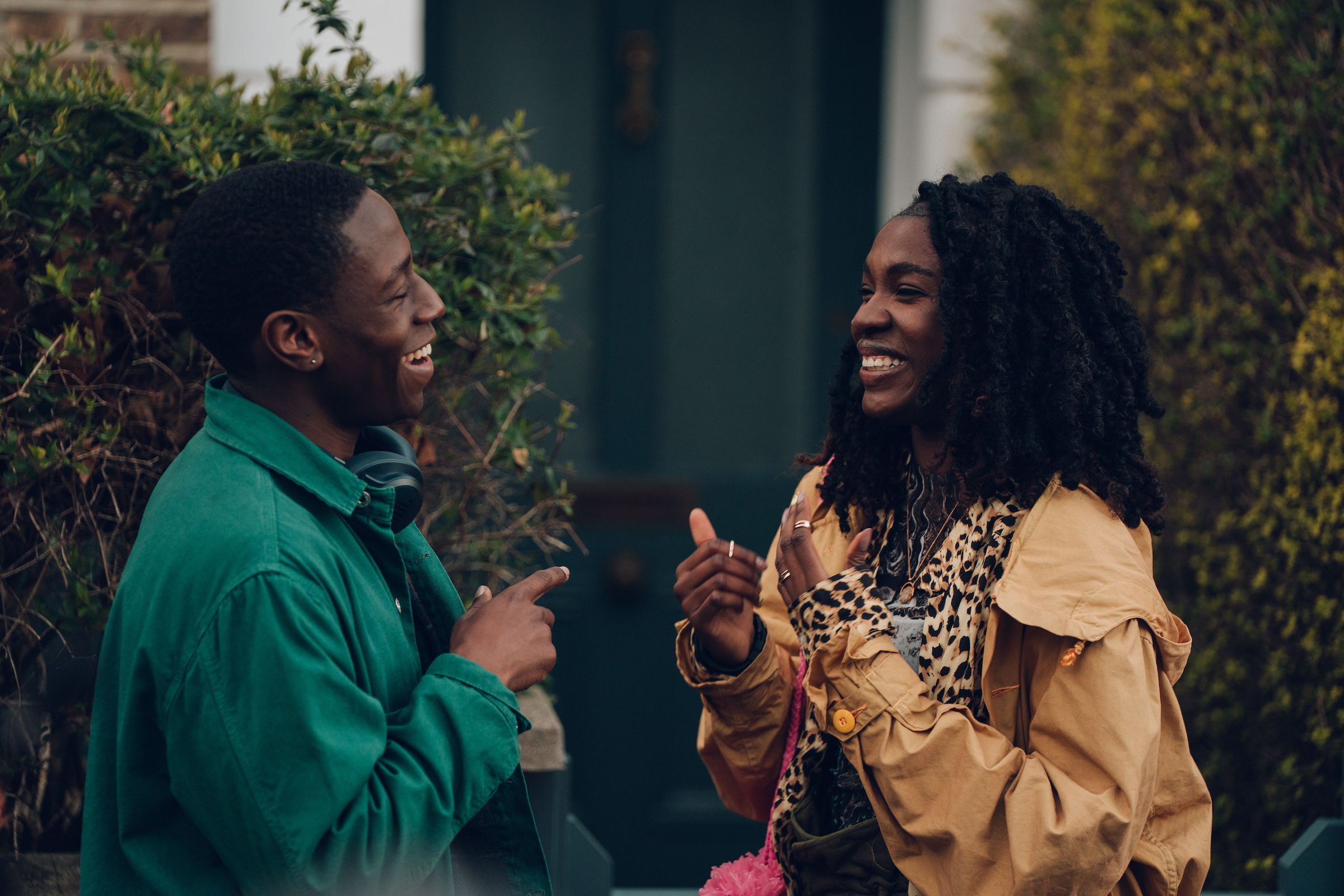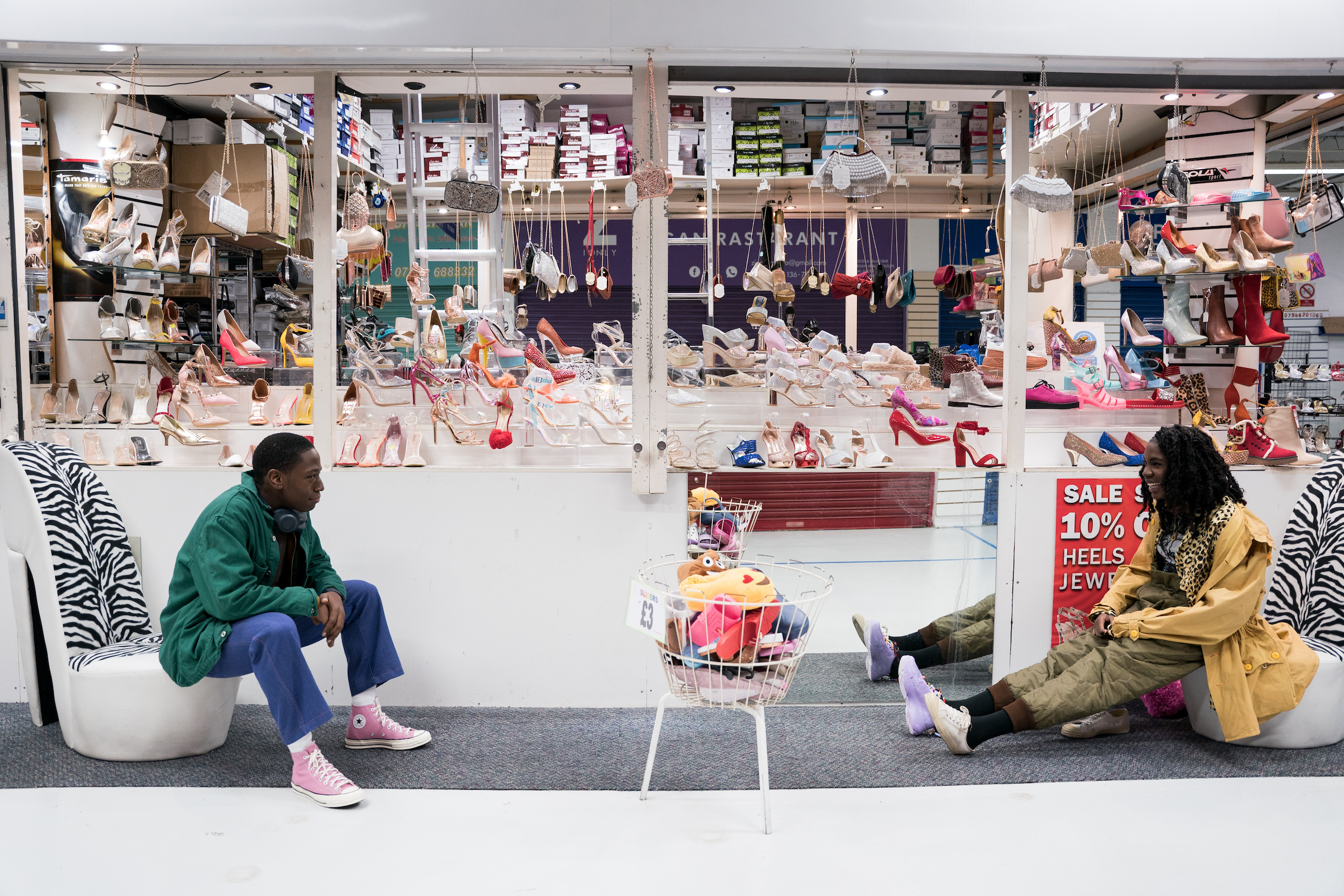
About half a decade ago, a fresh idea for a romantic comedy was born in a WhatsApp conversation between two screenwriters, Nathan Bryon and Tom Melia.
“Following on from what we were talking about,” one of them texted, “how about a modern day When Harry Met Sally, but set today in London?”
“You read my mind,” the other replied. “Cute dates in chicken shops.”
Rye Lane, the vibrant, slice-of-life rom-com that emerged from the conversation—and which arrives on Hulu on Friday—has its fair share of chicken shops.
In the movie—which evokes the 1995 film Before Sunrise, following its lead characters as they simply stroll and chat, growing closer as they bond over bad breakups—Dom (David Jonsson) recalls renting out Morley’s, a beloved South London fried chicken joint, as an anniversary date grand gesture for his ex-girlfriend, Gia (Karene Peter). As a cute nod to their first date, when the two ended up at Morley’s late at night, he set the table with candles, roses, goblets of wine—and Gia wasn’t impressed. But Yas (Vivian Oparah), to whom Dom is recounting this story, loves the idea.
“That is literally my dream date,” Yas tells Dom in the present day. “In fact, if I had a restaurant, I’d call it Nuggets by Candlelight.” Later, she puts her number into his phone as “Yas (nuggets by candlelight).”
Read More: The 49 Most Anticipated Movies of 2023
While Bryon and Melia came up with the genre and setting, it was director Raine Allen-Miller who brought Morley’s to the table. That is, it was her idea to make Rye Lane a love letter to South London—and the neighborhoods of Brixton and Peckham, specifically (the film was initially going to be set in North London). When Allen-Miller was 12, she moved to South London from Manchester. She grew up on a council estate in Brixton, and one of the first things she did was go to Brixton Market, a bustling street market featured in the film, with her grandmother. Although much of Brixton is historically Afro Caribbean, the area has begun to gentrify in recent years.
“Being able to go to a shop and buy a very specific Afro comb, and go and buy a Jamaican patty, and get plantain, and also go and get a flat white with oat milk is just an unusual, interesting thing,” Allen-Miller tells TIME, speaking from the mountains of Jamaica, where she’s visiting family. “Like sourdough bread and then hard dough bread.” (Hard dough bread is a dense, slightly sweet Jamaican staple.)

The cultural scramble of London is a compelling basis for a film, but it’s not necessarily a positive thing, Allen-Miller says. “Gentrification is a tough conversation.” Both Allen-Miller and the writers cite Spike Lee’s Do the Right Thing as inspiration: It’s a snapshot of a specific place—Bed-Stuy, Brooklyn—at a specific moment in time—1989, as the neighborhood is on the cusp of change.
“The key was to capture it now,” Allen-Miller says. “It was about going, ‘I’m going to represent a place that I know really well and a place that deserves to be represented correctly.’ Not just in a gritty way where it’s all about crime and sadness, but in a way that feels real and positive. It’s a Black British experience.”
Rye Lane captures its titular street on a good day. The director knows that South London, like any place, isn’t perfect. But—with splashes of color, wide lenses, and her trademark “accidentally art directed” style—she makes the setting messy but beautiful. Small details add texture: In Rye Lane Market, a cowboy in a sequined blue getup moonwalks across Yas and Dom’s path. In Brixton Market, rom-com royalty Colin Firth makes a cameo, serving spicy pork burritos at the cheekily named Love Guac’tually. Outside a house party, a woman in a Bridget Jones bunny costume smokes a cigarette.
Allen-Miller didn’t set out to make a rom-com—she actually never saw herself directing a film she hadn’t written—but fell for the script’s humor and simplicity. “It’s almost the opposite of the classic formula,” she says: It takes a funny, happy story, infuses it with a strong sense of place, and happens to make it romantic.
“We were really interested in knowing what a rom-com would look like in a London that we actually recognized,” says Melia, who also used to live in Brixton. “As much as we love those big, glossy, dream fulfillment rom-coms, they might as well be sci-fi as far as we’re concerned.”
The London that the writers know and love is populated by people who sound like their friends. That means slang, and lots of it.
In Rye Lane Market, Dom tells Yas that he’s an accountant. “So is that what you’ve always wanted to do,” Yas asks, “or have you got yourself some thwarted ambition burning away in your gut?” “You know, you’re very—” Dom replies. “Peng?” Yas interrupts. Other London vernacular includes: “safe” (good, cool), “prang out” (worry, panic), and “bare peas” (lots of money).

The movie prominently features two local cinemas: Brixton’s Ritzy—where Allen-Miller went with her dad growing up, and which Melia lived five minutes away from in his early 20s—and Peckhamplex, on Rye Lane itself. The production held community screenings at both theaters.
“Seeing it in Peckhamplex, there was an extra magical sprinkle,” says Bryon. “Because we saw the people who really understood that slang and were like, ‘Wait what?!’ There were little moments where it’s almost like someone’s talking your code. Someone knows.”
These writers know firsthand how much such lines matter: Melia is surrounded by actors in his family, and Bryon is an actor himself. “I understood the importance of creating really nuanced, interesting, diverse Black characters,” he says. Because when we started writing this movie, I definitely didn’t see those roles coming through to myself.”
The film opens and closes on art shows: Yas and Dom’s mutual friend Nathan (Simon Manyonda) is a photographer—in fact, his exhibition is why they’re in the same place at the same time at all. And Yas’ ex, Jules (Malcolm Atobrah), while arguably the worst, is also an admittedly talented sculptor. That was intentional: the creators wanted to portray working Black artists on screen.
Rye Lane is, as Allen-Miller puts it, “silly, wandering, tangible joy.” It feels like the way you would tell a story to a friend: elevated, colorful, but rooted in reality. And at its core, it celebrates the quirks and colors and magic of a place.
“I want all the wonderful American viewers to—when they come to London—yeah, do your Big Ben, do your Tower Bridge and all that, but go down to Rye Lane,” Bryon says. “Don’t do afternoon tea. Scrap that. Go to Morley’s on Rye Lane, get six wings and chips. Get a double chicken burger and thank us later.”
More Must-Reads from TIME
- Donald Trump Is TIME's 2024 Person of the Year
- Why We Chose Trump as Person of the Year
- Is Intermittent Fasting Good or Bad for You?
- The 100 Must-Read Books of 2024
- The 20 Best Christmas TV Episodes
- Column: If Optimism Feels Ridiculous Now, Try Hope
- The Future of Climate Action Is Trade Policy
- Merle Bombardieri Is Helping People Make the Baby Decision
Contact us at letters@time.com